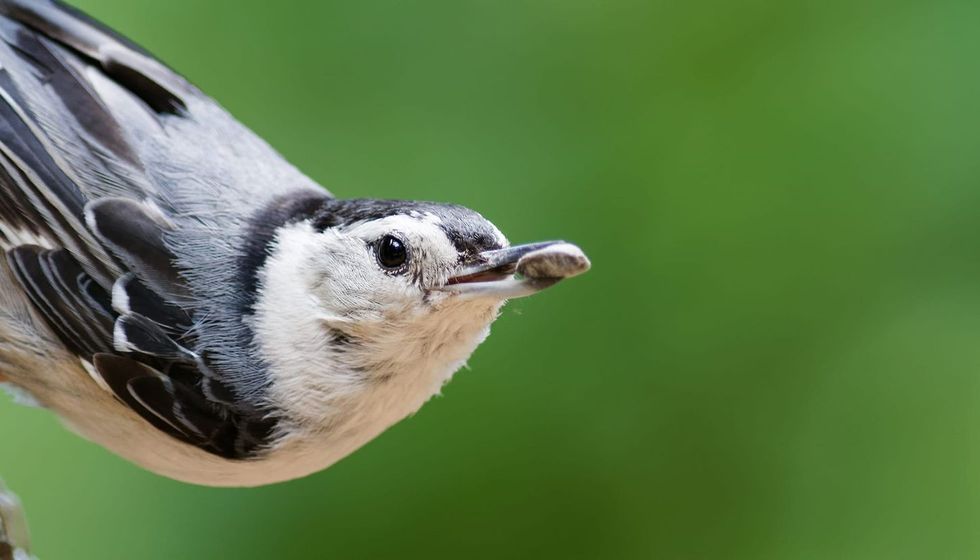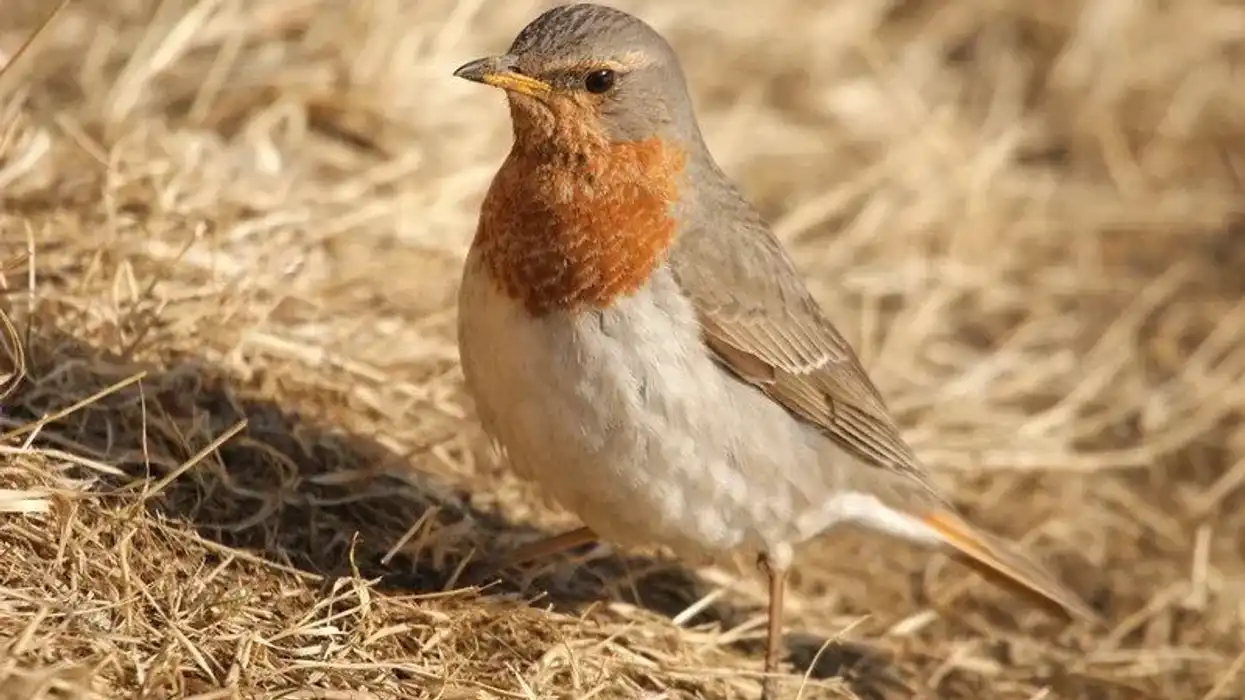The white-breasted nuthatch (Sitta carolinensis) is a small-sized singing bird, belonging to the nuthatch family.
Although there is rarely any difference between the male and female birds of the species, the males are slightly more vibrant than the females. The territory-conscious nuthatches join a flock only during foraging for seeds to store in the crevices in the bark of trees.
Foraging means gathering wild food. The monogamous birds pair with one individual and stay with them until they die or one of the birds disappears. During the breeding season, which takes place between May and June, the females themselves build the nests and lay eggs.
The birds lay only a single clutch of eggs in a single season. After a 12-14 days incubation period, the young birds take birth.
After 26 days the young nuthatches leave the nest. Although the birds can be abundantly found across the world, their predators possess a threat to them. Owls, hawks, and snakes are among their predators.
This adorable bird is full of interesting facts. Keep on reading to know more about the species.
Are you interested to learn interesting facts about birds and animals from around the globe? Then don't forget to visit our grasshopper sparrow and hooded merganser facts.
White-Breasted Nuthatch Interesting Facts
What type of animal is a white-breasted nuthatch?
The white-breasted nuthatch (Sitta carolinensis) is a small North American songbird, which belongs to the nuthatch family. Although small in size, these birds are the largest birds of the nuthatch family.
What class of animal does a white-breasted nuthatch belong to?
The white-breasted nuthatches belong to the Sittidae family. Birds belonging to this family are characterized by their large head, powerful feet, bill, and short tail.
How many white-breasted nuthatches are there in the world?
The exact number of white-breasted nuthatches living in the world is not known. However, white-breasted nuthatches are common songbirds and are among the most abundantly found birds in North America. They can also be found in the continental parts of the United States, southern regions of Canada, and central Mexico.
Where does a white-breasted nuthatch live?
The white-breasted nuthatches live abundantly throughout North America, the continental regions of the United States, central Mexico, and parts of southern Canada.
What is a white-breasted nuthatch's habitat?
The most preferred habitat of these birds is hardwood forests. They can also be found in coniferous forests, mixed deciduous, and deciduous woodlands. These birds also turn out to be frequent visitors of backyard bird feeders, as these bird feeders act as a source of food.
Who does a white-breasted nuthatch live with?
According to the Cornell Lab of Ornithology (a member-supported unit of Cornell University), territory-conscious birds live on their own throughout the year. It's only during traveling that a bird joins a flock. Flocks are considered beneficial to avoid predators and for foraging over tree trunks.
How long does a white-breasted nuthatch live?
The average lifespan of white-breasted nuthatches is two years. Although, the oldest bird of this species lived till the age of 10 years.
How do they reproduce?
This species of birds form monogamous pairs that stay together year-long, from courtship and territory establishment. This behavior continues until one of the birds in the pair disappears or dies.
The breeding season takes place between the beginning of May and the beginning of June, but some populations show a range that begins in April and continues until July. Every year, white-breast nuthatches lay a single clutch of eggs.
During the breeding season, female white-brown nuthatches build the nest by themselves. Nuthatches build their nests in tree cavities, also known as nest cavities. The females lay about 3-10 white-pink eggs in the nest cavity.
After an incubation period of 12-14 days, the eggs hatch, and the young birds are born. The young birds leave the nest between 14-26 days after birth.
What is their conservation status?
According to the International Union for Conservation of Nature (IUCN) Red List, the conversation status of the white-breasted nuthatches is Least Concern. The North American birds are abundantly found across the world and their population is even increasing.
White-Breasted Nuthatch Fun Facts
What does a white-breasted nuthatch look like?
White-breasted nuthatches are distinguished from other nuthatches by their long bills. Their bills are nearly as long as their heads and slightly upturned. Nuthatches with white breasts have black crowns on their heads, as well as white cheeks and undersides.
Their lower belly has a rosy region near the tail. The back of a nuthatch is bluish-gray.
Their wings and tails are a mix of black, white, and bluish-gray colors. Male birds are slightly more vibrantly colored than female birds, with dark parts of their plumage contrasting with their light plumage. Females have a slightly grayer complexion on average.

How cute are they?
These North American birds are extremely adorable and look cute, as well. However, these birds are extremely territorial and sensitive. While the male white-breasted nuthatches defend the territory, both the male and female white-breasted nuthatches reside in the territory. Only during winter, do white-breasted nuthatches leave their territory in search of food.
How do they communicate?
These birds use visual cues and vocalizations to communicate with birds from the species. These North American birds are almost quiet throughout the entire year, even during the breeding season. However, during early spring and winter, white-breasted nuthatches become particularly vocal. These songbirds sing to defend their territories.
How big is a white-breasted nuthatch?
White-breasted nuthatches can grow up to 6 in (15 cm) in length. They are 1.2 in (3 cm) longer than a similar species of nuthatches, named the red-breasted nuthatch. The red-breasted nuthatches are similar to the white-breasted nuthatches; the only difference is that their underparts are cinnamon-colored.
How fast can a white-breasted nuthatch fly?
The exact speed of the white-breasted nuthatches is not known.
How much does a white-breasted nuthatch weigh?
This bird has an average weight of 0.7 oz (19.8 g).
What are the male and female names of the species?
The white-breasted nuthatches do not have specific names for the male and female counterparts of the species. They are known by the name of the parent species. Therefore, male white-breasted nuthatches are known as cocks, whereas, female white-breasted nuthatches are known as hens.
What would you call a baby white-breasted nuthatch?
Similar to the male and female birds, the baby nuthatches also do not have a specific name. They are called chicks.
What do they eat?
These birds are omnivorous. Their food consists of both seeds and insects. During summer, the white-breasted nuthatches eat insects like weevils, leaf beetles, tent caterpillars, spiders, wood borers, scale insects, ants, and psyllids for food from the trees, while in winter, white-breasted nuthatches eat (sunflower) seeds and nuts from the trees in their habitat.
This bird has a habit of storing seeds and nuts in tree crevices or loose bark of trees in their habitat. They get their name 'nuthatches' from their habit.
Later when they need food, they pry open the crevices in the bark of the trees with their bills. Nuthatches also look for smaller seeds and insects along the tree trunks.
Are they dangerous?
These birds are not at all dangerous. Their behavior does not possess any threat to humans. Instead, these birds are quite friendly.
Would they make a good pet?
Although these birds look adorable and are quite friendly, they do not make ideal pets. They are most suited to the wild habitat. However, they might just become frequent visitors to your backyard, where they might feed on insects or seeds like sunflower seeds.
Did you know...
These birds have one backward-facing toe, along with three forward-facing toes. It helps them move head first, upside down on a tree, to eat from the crevices in the bark of the trees.
Why do nuthatches hang upside down?
The most concrete theory behind the behavior of these birds hanging upside down along tree trunks is that it gives a different perspective and helps them in foraging. Foraging is one of the most distinct characteristics of these birds and is also a prominent way through which these birds gather and eat food.
They even eat in an upside-down manner, so that when they look up, their head will remain parallel to the ground.
What's the difference between a chickadee and a nuthatch?
Although the two birds look quite similar, an adult black-capped chickadee has a longer tail and a smaller bill, when compared to nuthatches. They also do not climb up and down tree trunks, in search of nuts and seeds, like nuthatches.
Here at Kidadl, we have carefully created lots of interesting family-friendly animal facts for everyone to discover! Learn more about some other birds from our golden oriole fun facts and common house martin interesting facts pages.
You can even occupy yourself at home by coloring in one of our free printable white-breasted nuthatch coloring pages.










